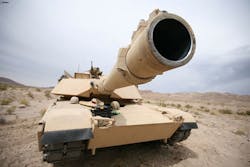Defense budget procurement and research headed in opposite directions: refilling the pipeline?
First, we shouldn't make more of this than what it is. The fiscal 2018 U.S. Department of Defense (DOD) budget, submitted to Congress late last month, contains $125.23 billion for procurement, which is down 6.2 percent over 2017's procurement request of $133.5 billion.
This is odd in itself, in a new era where President Donald Trump has pledged to grow the military budget to rebuild U.S. defense forces. The procurement budget generally contains spending for new military ships, aircraft, land vehicles, and other military equipment.
In addition, the procurement budgets for the U.S. Army, Navy, and Air Force all have cuts next year compared to this year -- including across-the-board cuts to military aircraft procurement.
Once again, I don't want to make too much of this, because overall the 2018 DOD budget proposal is up, year-over-year. It asks Congress for an overall increase of nearly 9 percent to the fiscal 2018 Pentagon budget, or $639.1 billion, up from 2017's request of 586.7 billion, and is the largest DOD topline budget request since 2012.
Still, I have to wonder about cuts in military procurement -- especially in light of big ... really big ... proposed increases in next year's Pentagon budget for research, development, test, and evaluation (RDT&E). DOD wants $82.33 billion next year for RDT&E, which is up more than $11 billion -- or 15.2 percent -- over 2017's RDT&E request of $73.32 billion.
It's the biggest RDT&E budget request in more than 10 years. So where does that leave us, with military procurement and research headed in opposite directions?
I don't know the answer for sure, but I'll speculate: I think the U.S. military may be at a substantial transition point when it comes to defense technology. Many of the nation's front-line military platforms, such as the M-1 Abrams main battle tank, AH-64 Apache attack helicopter, UH-60 Black Hawk helicopter, and Ticonderoga-class cruiser have been in the inventory for decades.
It's not that these relatively old platforms are being left to atrophy; far from it, in fact. Many of these older systems are being upgraded and recapitalized at very fast rates, and some of today's most promising enabling technologies in sensors, embedded computing, and machine control are being brought to bear on these systems.
Still, putting the brakes on procurement, while hitting the accelerator on research and development, could mean that it's time to start moving from the old to the new. Could it be that the next five or ten years could see major new platforms on land, in the air, and at sea?
It might seem so. The Air Force is in the early stages of developing a new long-range stealthy jet bomber. The Army is ramping-up production of the Joint Light Tactical Vehicle, Armored Multi-Purpose Vehicle, and Family of Heavy Tactical Vehicles. The Navy is taking delivery of its first new class of aircraft carriers since the mid-1970s.
Meanwhile, deliveries of new Virginia-class attack submarines are proceeding swiftly, the Army is proposing major upgrades to the M-1 Abrams tank, and the Air Force is making big improvements to the F-15 combat jet.
Optimistically, I think that major increases in the DOD military research budget may indicate a refilling of the technology development pipeline. I think we'll see improvements in military capabilities over the next five years that we haven't seen for decades.
If you're in the military technology business, I think this is reason for celebration.
Learn more: search the Aerospace & Defense Buyer's Guide for companies, new products, press releases, and videos
